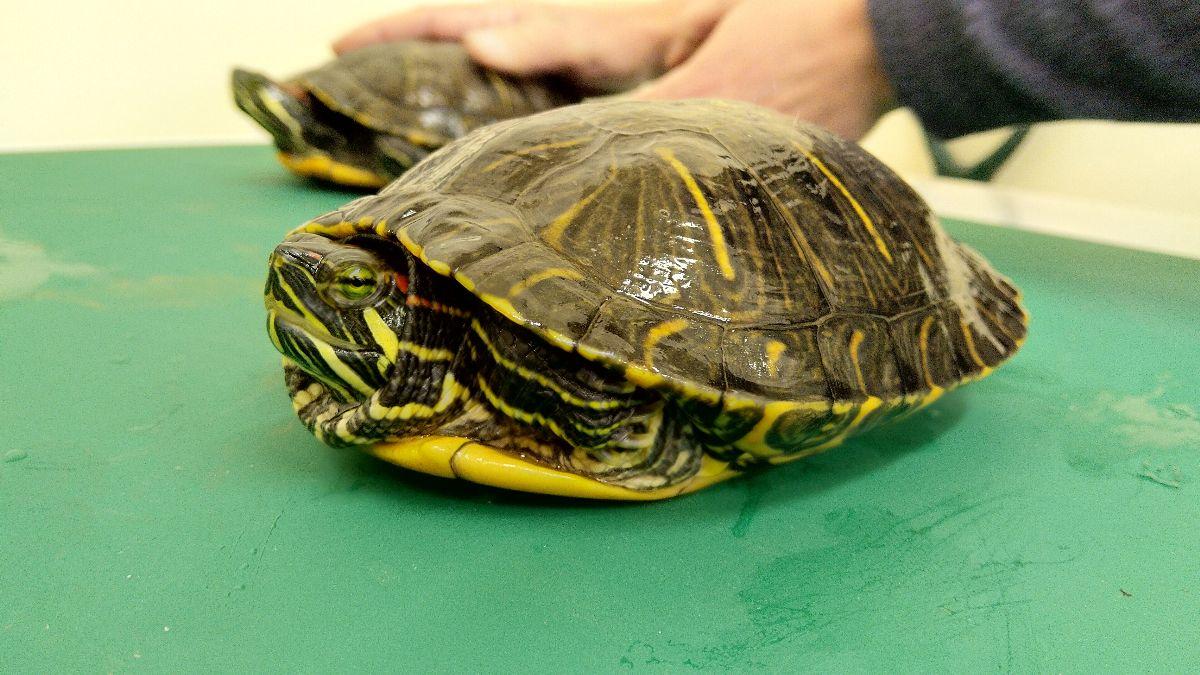Forensic chemistry used to combat illegal wildlife trade

The red-eared slider turtle is listed as an Australian Government priority exotic environmental pest and has also been identified by the World Conservation Union as one of the top 100 global invasive pests.
Image by Katherine Hill.
With illegal wildlife trade a major concern in Australia, University of Adelaide researchers have validated a new technique which uses forensic chemistry to identify provenance of an individual specimen from an alien species.
Using the red-eared slider turtle (REST) as a model species, this unique Centre for Invasive Species Solutions-supported research was recently published in the journal NeoBiota.

Katherine Hill is analysing a red-eared slider turtle shell sample as part of her studies to further develop this new forensics chemistry technique.
Image by Katherine Hill.
Andreas Glanznig, CEO of the Centre for Invasive Species Solutions said that REST is an important model since it is listed as an Australian Government priority exotic environmental pest and has also been identified by the World Conservation Union as one of the top 100 global invasive pests.
“More than 10 million RESTs are exported globally, including illegally to Australia, from their native range in the US, as they considered popular pets,” Andreas says.
“Unfortunately, due to this illegal trade, increasing numbers are now being found in the wild around Australian cities, which if left unmanaged could wreak havoc on our native flora and fauna.”
The technique was validated as part of Katherine Hill’s honours research studying 12 red-eared slider turtle samples from known and unknown origins to best tailor this new method.
“As the turtle shell grows slowly, we can learn what these turtles were eating up to 12 months ago, using our chemistry techniques,” Katherine says.
“For example, if analysis shows that a shell sample has higher nitrogen stable isotope ratio, we expect that turtle has been eating enriched protein like pet food and was likely in captivity.
“This is important as it can help support the origins of individuals found in the wild and potentially how long it has been there, allowing biosecurity officers to determine the best course of future management action.”
This detection technique forms part of a suite of new detection tools our centre’s collaboration is developing to help future proof Australia’s biosecurity system.
“This new forensic chemistry technique builds on the REST environmental DNA detection technology being developed by University of Canberra researchers, which could be used in addition to further identify the extent of a REST incursion, particularly in waterways where you are concerned there may be others,” Andreas says.
“This research all helps drive an innovation centred transformation of Australia’s biosecurity system so that new efficient technologies can be deployed to counteract the increasing biosecurity risks from growing trade.
“Detecting and subsequently avoiding the next pest animal threat, is just as important as managing current ones, and our centre is working on delivering these new technologies to ensure that exotic pets don’t become our next national pest.”
Katherine is now completing her PhD studies under the supervision of Associate Professor Phill Cassey.
Katherine's research is supported by the CISS and is expanding the use of this technology to use on other species, including native Australian parrots, and investigating if stable isotopes can track the spread of already established invasive species.
This research is part of a suite of projects within the Centre for Invasive Species Solutions incursions program looking at new and novel exotic species detection techniques, funded by the Australian Government Department of Agriculture, Water and Environment.
Further reading
- Pet or pest? Stable isotope methods for determining the provenance of an invasive alien species, NeoBiota
- Pest animal research programs, Centre for Invasive Species Solutions
